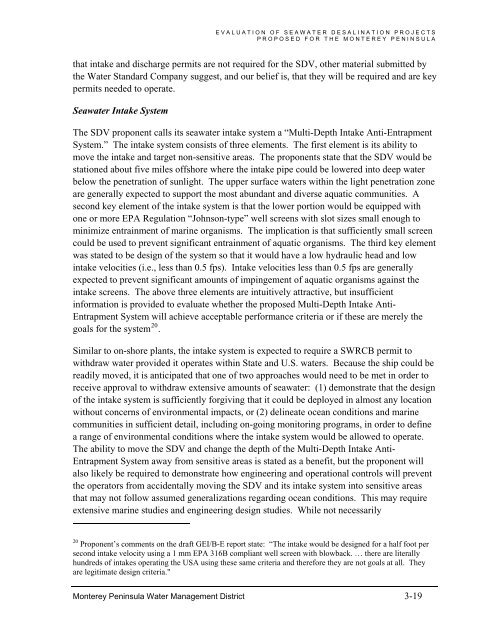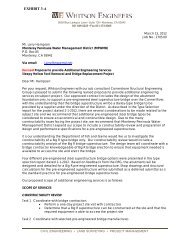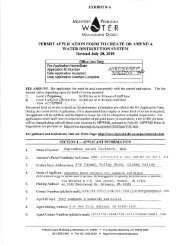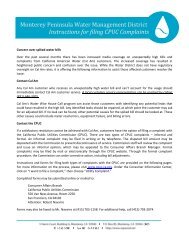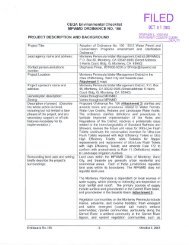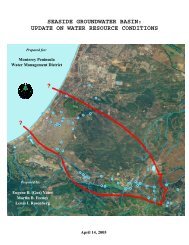FINAL REPORT Evaluation of Seawater Desalination Projects ...
FINAL REPORT Evaluation of Seawater Desalination Projects ...
FINAL REPORT Evaluation of Seawater Desalination Projects ...
You also want an ePaper? Increase the reach of your titles
YUMPU automatically turns print PDFs into web optimized ePapers that Google loves.
EVALUATION OF SEAWATER DESALINATION PROJECTS<br />
PROPOSED FOR THE MONTEREY PENINSULA<br />
that intake and discharge permits are not required for the SDV, other material submitted by<br />
the Water Standard Company suggest, and our belief is, that they will be required and are key<br />
permits needed to operate.<br />
<strong>Seawater</strong> Intake System<br />
The SDV proponent calls its seawater intake system a “Multi-Depth Intake Anti-Entrapment<br />
System.” The intake system consists <strong>of</strong> three elements. The first element is its ability to<br />
move the intake and target non-sensitive areas. The proponents state that the SDV would be<br />
stationed about five miles <strong>of</strong>fshore where the intake pipe could be lowered into deep water<br />
below the penetration <strong>of</strong> sunlight. The upper surface waters within the light penetration zone<br />
are generally expected to support the most abundant and diverse aquatic communities. A<br />
second key element <strong>of</strong> the intake system is that the lower portion would be equipped with<br />
one or more EPA Regulation “Johnson-type” well screens with slot sizes small enough to<br />
minimize entrainment <strong>of</strong> marine organisms. The implication is that sufficiently small screen<br />
could be used to prevent significant entrainment <strong>of</strong> aquatic organisms. The third key element<br />
was stated to be design <strong>of</strong> the system so that it would have a low hydraulic head and low<br />
intake velocities (i.e., less than 0.5 fps). Intake velocities less than 0.5 fps are generally<br />
expected to prevent significant amounts <strong>of</strong> impingement <strong>of</strong> aquatic organisms against the<br />
intake screens. The above three elements are intuitively attractive, but insufficient<br />
information is provided to evaluate whether the proposed Multi-Depth Intake Anti-<br />
Entrapment System will achieve acceptable performance criteria or if these are merely the<br />
goals for the system 20 .<br />
Similar to on-shore plants, the intake system is expected to require a SWRCB permit to<br />
withdraw water provided it operates within State and U.S. waters. Because the ship could be<br />
readily moved, it is anticipated that one <strong>of</strong> two approaches would need to be met in order to<br />
receive approval to withdraw extensive amounts <strong>of</strong> seawater: (1) demonstrate that the design<br />
<strong>of</strong> the intake system is sufficiently forgiving that it could be deployed in almost any location<br />
without concerns <strong>of</strong> environmental impacts, or (2) delineate ocean conditions and marine<br />
communities in sufficient detail, including on-going monitoring programs, in order to define<br />
a range <strong>of</strong> environmental conditions where the intake system would be allowed to operate.<br />
The ability to move the SDV and change the depth <strong>of</strong> the Multi-Depth Intake Anti-<br />
Entrapment System away from sensitive areas is stated as a benefit, but the proponent will<br />
also likely be required to demonstrate how engineering and operational controls will prevent<br />
the operators from accidentally moving the SDV and its intake system into sensitive areas<br />
that may not follow assumed generalizations regarding ocean conditions. This may require<br />
extensive marine studies and engineering design studies. While not necessarily<br />
20 Proponent’s comments on the draft GEI/B-E report state: “The intake would be designed for a half foot per<br />
second intake velocity using a 1 mm EPA 316B compliant well screen with blowback. … there are literally<br />
hundreds <strong>of</strong> intakes operating the USA using these same criteria and therefore they are not goals at all. They<br />
are legitimate design criteria."<br />
Monterey Peninsula Water Management District 3-19


